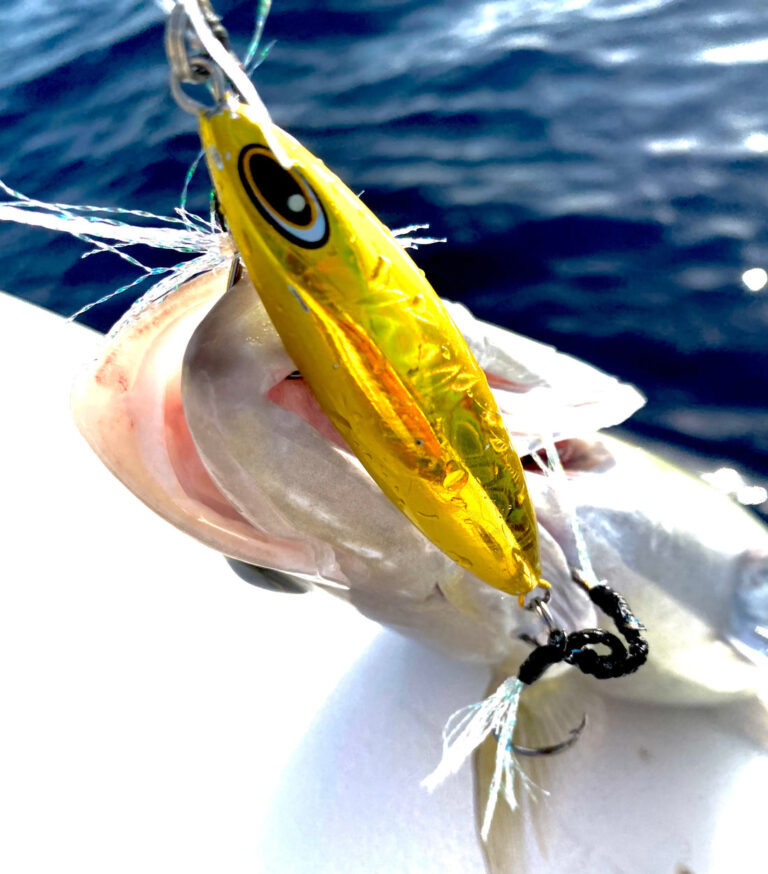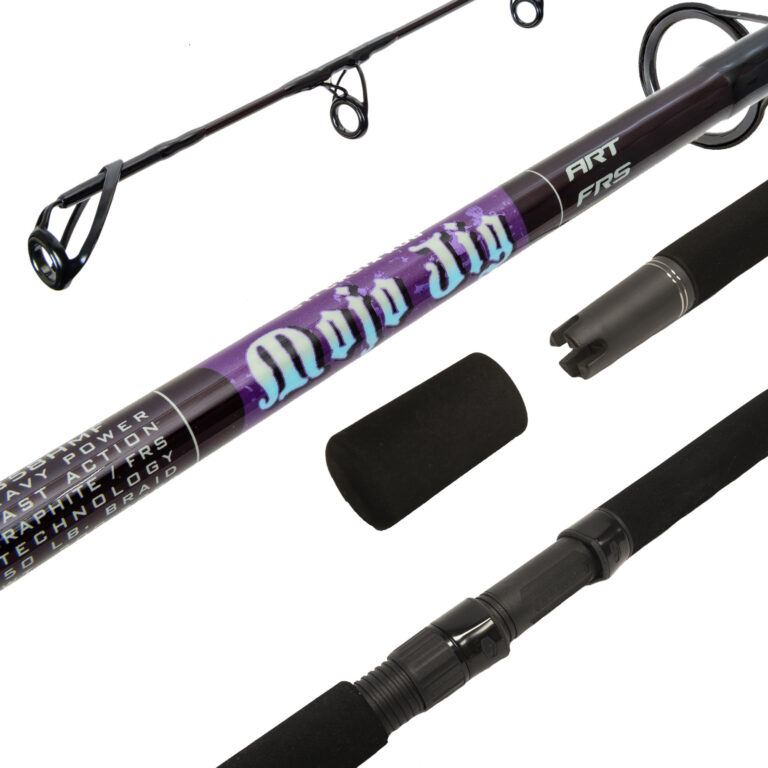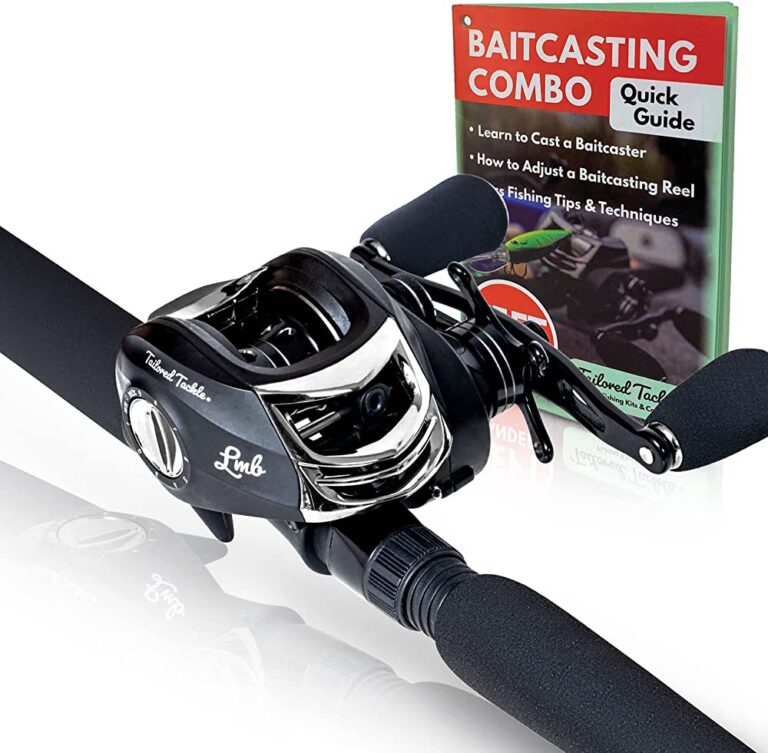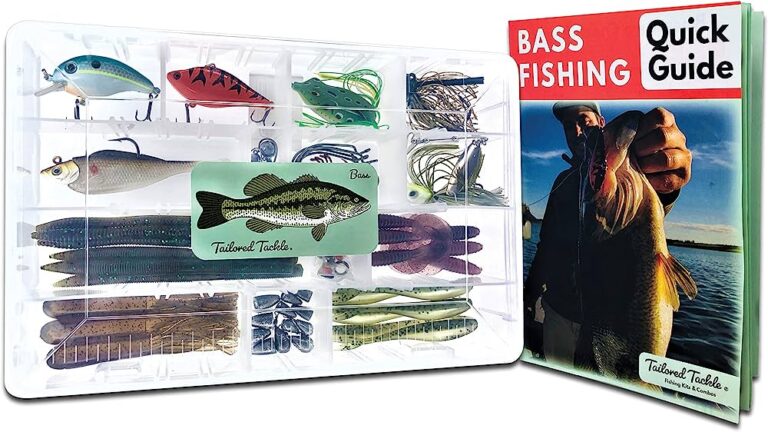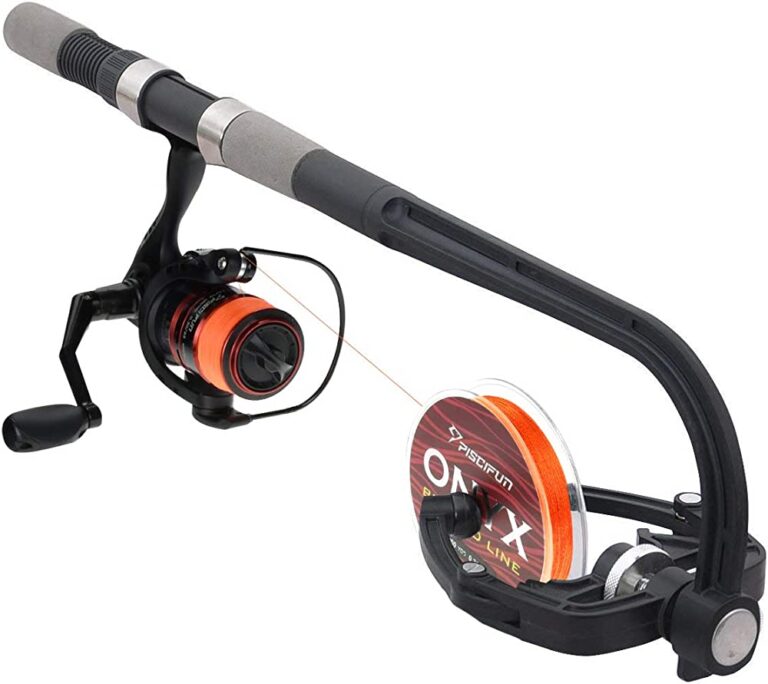Yes, there are spinning rods specifically designed for bass fishing, offering anglers the optimal performance for targeting this popular freshwater species. With their specialized design features, such as sensitive tip action and enhanced casting capabilities, these rods help anglers achieve precise casts and have better control over their presentations, resulting in more successful bass catches.
Additionally, the spinning rod’s versatile nature allows anglers to adapt their fishing techniques to various bass fishing conditions and environments, making it a popular choice among bass fishing enthusiasts. These rods come in different lengths, power ratings, and materials, providing anglers with a wide range of options to match their specific preferences and fishing styles.
So, whether you’re a beginner or an experienced angler, choosing a spinning rod dedicated to bass fishing can greatly enhance your fishing experience with increased accuracy and success.

Credit: jonboataccessories.com
Importance Of Choosing The Right Spinning Rod For Bass Fishing
Choosing the right spinning rod is crucial for a successful bass fishing expedition. With so many options available in the market, it can be overwhelming to decide which rod to invest in. However, by considering a few key factors, you can make a well-informed decision and improve your chances of landing that trophy bass.
Let’s explore the important factors to consider when selecting a spinning rod for bass fishing.
Factors To Consider When Selecting A Spinning Rod
Length, power, and action:
- The length of the spinning rod affects casting distance and control. Longer rods typically provide increased casting distance, while shorter rods offer better maneuverability in tight spaces.
- Power refers to the amount of pressure required to bend the rod. Bass fishing generally necessitates a medium to medium-heavy power rod for optimal performance.
- Action refers to how much the rod flexes under pressure. Fast action rods bend near the tip, offering increased sensitivity, while moderate or slow action rods bend closer to the middle, providing a more forgiving experience.
Material and construction:
- Graphite rods are popular due to their lightweight nature, sensitivity, and durability. They are ideal for bass fishing, as they allow you to feel subtle bites and make accurate casts.
- Fiberglass rods, on the other hand, are more flexible and provide excellent shock absorption, making them suitable for fishing in heavy cover areas where bass are likely to hide.
Handle and grip options:
- The handle of a spinning rod plays a crucial role in providing comfort and control while fishing. It should be comfortable to hold for long periods and provide a firm grip, even when wet.
- Cork and eva foam are popular handle materials, offering good grip and durability.
- Some rods also feature split grips, which reduce weight and provide better balance.
Reel seat compatibility:
- Ensure that the spinning rod you choose has a reel seat compatible with your preferred reel model. A secure and properly fitted reel seat ensures smooth operation and minimizes the risk of any mishaps while reeling in a bass.
Sensitivity and responsiveness:
- A sensitive spinning rod allows you to detect the subtlest of movements, enabling you to feel when a bass strikes the bait. Look for a rod that offers good sensitivity to improve your catch rate.
- Responsive rods also enhance your ability to make quick and accurate casts, allowing you to cover more water and increase your chances of enticing a bass to bite.
By considering these factors when selecting a spinning rod for bass fishing, you can make an informed decision and maximize your chances of a successful outing. Remember, the right spinning rod can make a world of difference in your fishing experience, so choose wisely and gear up for an exciting adventure on the water!
Key Features Of Spinning Rods Optimized For Bass Fishing
Lightweight And Balanced Design
- Spinning rods optimized for bass fishing are designed to be lightweight and balanced, providing several benefits for anglers.
- The lightweight design allows for increased casting accuracy, as the angler can make more precise and controlled casts.
- A balanced rod ensures that the weight is evenly distributed, reducing fatigue and discomfort during long hours of fishing.
Power And Action Suited For Bass Fishing Techniques
- Bass fishing requires specific rod power and action to effectively handle different fishing techniques.
- Power refers to the rod’s lifting strength and its ability to handle heavy loads when hooking and fighting bass.
- Action describes how the rod flexes and bends under pressure, affecting the sensitivity and control over the bait or lure.
Understanding Power And Action Ratings
- Rod power is usually indicated by a rating such as ultralight, light, medium, or heavy. The rating indicates the rod’s ability to handle different line weights and lure sizes.
- Action is classified as fast, medium, or slow. Fast action rods bend mostly at the tip, providing increased sensitivity, while slow action rods flex along the entire length, enabling a more forgiving experience.
Selecting The Right Combination For Various Techniques
- Topwater fishing: Opt for a medium power rod with a fast action, allowing for accurate casts and quick hooksets when bass strike on the water surface.
- Texas rigging: Choose a medium-heavy power rod with a moderate fast action, providing the strength to pull fish out of heavy cover and detect subtle bites.
- Drop shot: Select a medium or medium-light power rod with a fast or extra fast action, enabling precise presentations and enhanced sensitivity for detecting light nibbles.
- Finesse fishing: Look for a light or ultralight power rod with a fast or extra fast action, ensuring optimal sensitivity and delicacy when using finesse techniques.
Sensitivity And Backbone For Detecting Bites And Fighting Bass
- Sensitivity plays a crucial role in bass fishing, allowing anglers to detect even the subtlest strikes from bass. A highly sensitive rod aids in feeling bites and helps with timely hooksets.
- The backbone, also known as the rod’s strength, is essential for hooksets and fighting fish. It ensures that you can efficiently set the hook into a bass’s mouth and handle vigorous fights without compromising control.
Remember, the key to successful bass fishing lies in selecting the right rod optimized for the specific techniques and conditions you’ll encounter on the water. A lightweight and balanced design, coupled with appropriate power and action, will enhance your casting accuracy, sensitivity, and ability to land those elusive bass.
So choose wisely and get ready to reel in some great catches!
Comparing Different Types Of Spinning Rods For Bass Fishing
Graphite Vs. Fiberglass Rods
When it comes to choosing the right spinning rod for bass fishing, the material of the rod plays a crucial role. The two most common materials used in spinning rods are graphite and fiberglass. Each material has its own set of pros and cons that anglers should consider before making a decision.
Pros And Cons Of Graphite Rods
Graphite rods are lightweight and highly sensitive, making them a popular choice among bass anglers. Here are some key points to consider when it comes to graphite rods:
- Lightweight: Graphite rods have a higher strength-to-weight ratio compared to fiberglass rods, making them easier to handle and reducing fatigue during long fishing sessions.
- Sensitivity: Graphite rods offer excellent sensitivity, allowing anglers to detect even the slightest nibbles and vibrations. This sensitivity is crucial when fishing in areas with heavy cover or when bass are being finicky.
- Stiffness: Graphite rods are stiffer, providing better accuracy and casting distance. This makes them ideal for techniques that require precise casts, such as finesse fishing or targeting specific structures.
However, there are a few drawbacks to using graphite rods as well:
- Durability: Graphite rods are more prone to breaking under heavy loads or when mishandled. Their brittleness makes them less forgiving compared to fiberglass rods.
- Price: Graphite rods tend to be more expensive than fiberglass rods due to the higher cost of materials and manufacturing.
Pros And Cons Of Fiberglass Rods
Fiberglass rods have their own advantages and disadvantages that anglers should consider before making a decision. Here are some key points to keep in mind:
- Durability: Fiberglass rods are known for their durability and strength, making them a great choice for anglers who frequently fish in heavy cover or battle with larger bass. They can withstand more abuse without breaking.
- Flexibility: Fiberglass rods have a slower action, providing more forgiveness when fighting fish. This allows anglers to apply more pressure during the fight without worrying about rod failure.
- Price: Fiberglass rods are generally more affordable compared to graphite rods, making them a budget-friendly option for anglers.
However, there are a few downsides to using fiberglass rods:
- Weight: Fiberglass rods are heavier compared to graphite rods, which can result in fatigue during long fishing sessions.
- Sensitivity: Fiberglass rods are less sensitive compared to graphite rods, making it more challenging to feel subtle movements and bites.
Choosing The Right Material Based On Fishing Conditions And Preferences
The decision between graphite and fiberglass rods ultimately depends on the fishing conditions and angler preferences. Consider the following factors when selecting the right material for your bass fishing needs:
- Fishing techniques: Graphite rods excel in finesse fishing techniques such as drop shotting or using lightweight soft plastics, where sensitivity and accuracy are crucial. Fiberglass rods are better suited for power fishing techniques such as flipping and pitching heavy baits, where durability and strength are important.
- Fishing conditions: In clear waters with light cover, graphite rods can provide an advantage with their increased sensitivity. In areas with heavy cover or when targeting larger bass, fiberglass rods’ durability and forgiveness make them a reliable choice.
- Budget: Graphite rods tend to be pricier compared to fiberglass rods. Consider your budget and investment in fishing gear before making a decision.
One-Piece Vs. Two-Piece Rods
Another consideration when choosing a spinning rod for bass fishing is whether to go for a one-piece or two-piece rod design. Each option has its own set of advantages and disadvantages.
Advantages And Disadvantages Of One-Piece Rods
One-piece rods are made from a single continuous blank, offering anglers several benefits. Here are the key points to consider:
- Sensitivity and performance: One-piece rods provide better sensitivity and overall performance due to their seamless construction. They transmit vibrations more effectively, allowing anglers to detect subtle strikes.
- Strength and durability: One-piece rods are generally stronger and more durable compared to their two-piece counterparts. There are no weak points or joints in the blank that could compromise the rod’s integrity.
- Action: One-piece rods deliver consistent action throughout the entire length, resulting in better casting accuracy and control.
However, there are a few potential downsides to using one-piece rods:
- Transportation: One-piece rods are less portable and can be challenging to transport, especially in vehicles with limited space. They may require specialized rod holders or cases to prevent damage during transportation.
- Higher cost: One-piece rods tend to be more expensive compared to two-piece rods, as they require a single, uninterrupted blank.
Advantages And Disadvantages Of Two-Piece Rods
Two-piece rods consist of two separate sections that connect to form a complete rod. Here are the key points to consider:
- Portability: Two-piece rods are more portable and easier to transport, especially when traveling or hiking to fishing locations. They can be broken down into smaller pieces, fitting into compact cases or backpacks.
- Cost: Two-piece rods are generally more affordable than one-piece rods, making them a budget-friendly option for anglers.
- Versatility: Two-piece rods offer versatility, allowing anglers to carry different rods with varying actions or power ratings for different fishing conditions.
However, there are a few potential downsides to using two-piece rods:
- Less sensitivity: Two-piece rods may have slightly reduced sensitivity compared to one-piece rods due to the connection point between sections.
- Potential weak point: The connection point on two-piece rods can be a potential weak point in terms of durability. Extra care should be taken to avoid damaging or bending the locking mechanism.
Factors To Consider When Selecting Between The Two Options
Choosing between a one-piece and two-piece rod depends on your fishing needs and priorities. Consider the following factors before making a decision:
- Fishing style: If you primarily fish from a boat or have ample storage space, a one-piece rod may provide better performance and sensitivity. For anglers who frequently travel or hike to fishing spots, a portable two-piece rod might be more practical.
- Budget: One-piece rods are often pricier, while two-piece rods provide a budget-friendly alternative without compromising too much on performance.
- Fishing locations: Consider the types of fishing locations you frequent. If you frequently fish in tight spaces or have limited storage, a two-piece rod may be the more convenient choice.
- Target species and techniques: Some fishing techniques may require specific rod lengths, actions, or power ratings that are only available in one-piece or two-piece options. Consider your target species and fishing techniques when making a decision.
Spinning Rods Designed For Specific Bass Fishing Techniques
In addition to considering the material and design of spinning rods, anglers can also choose rods specifically designed for certain bass fishing techniques. These technique-specific rods are optimized to enhance performance and effectiveness in specific situations. Here are a few examples:
Pitching And Flipping Rods
- Purpose: Pitching and flipping rods are designed for accurate and close-quarters casting under vegetation or into heavy cover.
- Key features: These rods are typically longer, stiffer, and have heavier power ratings to handle heavy baits and allow for precise placement.
- Benefits: Pitching and flipping rods offer better control and accuracy when targeting bass in heavy cover and can handle larger lures.
- Considerations: These rods may sacrifice sensitivity for power, so they might not be the best choice for finesse techniques or fishing in open water.
Shakey Head Rods
- Purpose: Shakey head rods are designed for finesse techniques, specifically using a shakey head jig with soft plastic baits.
- Key features: These rods have light to medium power ratings and more moderate actions, allowing for subtle presentations.
- Benefits: Shakey head rods offer increased sensitivity to feel slight movements and bites while maintaining enough strength to handle larger bass.
- Considerations: Shakey head rods may lack the casting distance and power needed for heavy cover or larger baits.
Crankbait Rods
- Purpose: Crankbait rods are designed to optimize the performance of crankbaits, allowing for proper lure action and minimizing fatigue during extended use.
- Key features: These rods typically have moderate to moderate-fast actions to provide the necessary flex and forgiveness for crankbait fishing.
- Benefits: Crankbait rods enhance casting accuracy, lure control, and hook-setting capabilities when using different types and sizes of crankbaits.
- Considerations: These rods may not offer the same sensitivity as other rods since they prioritize lure action and minimizing fatigue.
Jerkbait Rods
- Purpose: Jerkbait rods are specifically designed to maximize the action and presentation of jerkbaits, facilitating the twitching and pausing technique.
- Key features: These rods have fast to extra-fast actions and medium power ratings to generate the sharp rod movements required for jerkbaits.
- Benefits: Jerkbait rods provide the necessary sensitivity, casting accuracy, and hook-setting power to successfully work jerkbaits and target bass in open water.
- Considerations: The fast action of jerkbait rods may result in a stiffer feel, which might limit their versatility for other fishing techniques.
Swimbait Rods
- Purpose: Swimbait rods are designed for fishing with larger swimbaits, delivering the power and action needed to handle big baits and target trophy bass.
- Key features: These rods are typically longer, have heavy to extra-heavy power ratings, and fast to extra-fast actions to accommodate the larger and heavier swimbaits.
- Benefits: Swimbait rods provide the necessary casting distance, control, power, and leverage when fishing with larger swimbaits while maintaining sensitivity.
- Considerations: The specialized design of swimbait rods may limit their effectiveness when used for other fishing techniques or lighter baits.
By choosing spinning rods designed for specific bass fishing techniques, anglers can maximize their performance and increase their chances of success on the water. Remember to select the appropriate rod that suits your fishing style, preferred technique, and target species to optimize your overall experience.
Maintenance Tips And Techniques For Spinning Rods
Spinning rods offer a great advantage for bass fishing, providing anglers with the ability to cast lighter lures and achieve greater accuracy. To keep your spinning rod in top condition and ensure optimal performance, it is essential to follow proper maintenance techniques.
Here are some useful tips to help you clean, store, and maintain your spinning rod:
Cleaning And Storing Your Spinning Rod
A clean and well-maintained spinning rod not only lasts longer but also performs better on the water. Here’s how you can keep your spinning rod in pristine condition:
- Regularly wipe down your spinning rod with a soft cloth to remove any dirt or debris that may have accumulated during your fishing trips.
- Use a mild detergent or soap mixed with water to clean the rod thoroughly, paying attention to the reel seat, guides, and handle.
- Rinse the rod with clean water to remove any soap residue, and dry it with a towel.
- Avoid using abrasive cleaners or scrub brushes, as they can damage the rod’s finish.
- When not in use, store your spinning rod in a rod holder or a protective case to prevent it from getting bumped or bent.
Proper Cleaning Methods To Extend The Lifespan
Properly cleaning your spinning rod not only helps keep it looking great but also extends its lifespan. Here are a few tips to ensure you clean your rod correctly:
- Start by removing the reel from the rod, as it will make the cleaning process easier and more effective.
- Gently clean the rod guides using a soft brush or a cotton swab dipped in a mild cleaning solution.
- Pay close attention to the guide inserts, as these can accumulate dirt and affect the line’s smooth movement.
- Once cleaned, rinse the guides with water and dry them thoroughly.
- Clean the reel seat by wiping it with a damp cloth, ensuring that no debris or dirt is left behind.
- Finally, wipe down the handle grip with a clean cloth and consider using a silicon-based conditioner to protect and preserve the grip material.
How To Store The Rod To Prevent Damage
Proper storage is key to preventing damage and maintaining the integrity of your spinning rod. Follow these guidelines to store your rod correctly:
- Avoid leaving your rod in direct sunlight for extended periods, as uv rays can cause damage to the rod blank and other components.
- Store your spinning rod in a dry and cool place, away from humidity, which can lead to corrosion and rust.
- If possible, store your rod horizontally or vertically on a rod rack, as this helps distribute the weight evenly and reduces the risk of warping or bending.
- Consider using a rod sleeve or a rod sock to prevent scratches or abrasions when storing multiple rods together.
- Always make sure the rod is dry before storing it to prevent mold or mildew growth.
- Check the rod guides and reel seat periodically, especially before storing your rod for an extended period. Any signs of damage should be addressed before storage to avoid further deterioration.
Checking And Replacing Rod Guides
Rod guides play an essential role in casting and retrieving your line smoothly. Over time, guides can wear out or become damaged, affecting your rod’s performance. Here’s how you can check and replace rod guides if needed:
- Inspect each guide on your spinning rod for any signs of wear, such as cracks, chips, or bent frames.
- Run a cotton ball or nylon stocking through each guide to feel for any rough spots that could damage your fishing line.
- If you notice any issues, consider replacing the damaged guide. Replacement guides can be purchased from tackle shops or online.
- To replace a guide, carefully remove the old guide using a heat gun or a hairdryer to soften the adhesive, then clean the area where the new guide will be installed.
- Apply a high-quality rod guide epoxy adhesive to secure the new guide in place, following the manufacturer’s instructions.
- Allow the adhesive to cure completely before using your spinning rod again.
Signs Of Wear And Tear On Guides
Regular inspections of your rod guides are crucial to catch any wear and tear before it affects your fishing experience. Look out for the following signs:
- Ceramic inserts in the guides may crack or chip over time due to impact or stress, which can cause the line to fray or break.
- Bent or misaligned frames can also impact the line’s movement, leading to decreased casting distance and accuracy.
- Corrosion or rust on the guides can cause friction, which may result in line damage or reduced sensitivity.
- Rough or damaged guides can fray or weaken the line, leading to increased likelihood of breakage during fishing.
Steps To Replace Damaged Or Worn-Out Guides
Replacing damaged or worn-out guides is a straightforward process that you can do yourself. Here’s a step-by-step guide to guide replacement:
- Gather the necessary tools, including a heat gun or hairdryer, epoxy adhesive, alcohol wipes, cotton swabs, and a small brush.
- Heat the old guide’s adhesive using the heat gun or hairdryer until it softens, making it easier to remove the old guide.
- Clean the guide area with alcohol wipes to remove any residues from the old adhesive.
- Apply the epoxy adhesive to the guide foot and carefully position the new guide using a guide wrapping tool or a similar device.
- Ensure the guide is aligned correctly and secured tightly in place.
- Allow the adhesive to cure fully, following the manufacturer’s instructions.
- Repeat the process for any additional guides that need replacement.
- Once all the guides are securely in place, inspect and test the rod to ensure smooth line movement and optimal performance.
Conclusion
After careful analysis, it is evident that spinning rods designed specifically for bass fishing do exist. These rods are engineered with the specific needs and preferences of bass anglers in mind. They incorporate features such as extra sensitivity and flexibility, allowing for precise control and the ability to detect even the subtlest of strikes.
Additionally, these rods are typically lightweight and well-balanced, reducing fatigue and improving overall performance. By opting for a spinning rod specifically designed for bass fishing, anglers can greatly enhance their chances of success on the water. With the right rod in hand, they can confidently cast their lures with accuracy and finesse, increasing their chances of hooking that trophy bass.
So, whether you are a professional angler or a weekend enthusiast, investing in a spinning rod designed for bass fishing is a decision that can greatly elevate your fishing experience.

